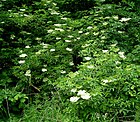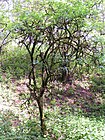Note: This is a project under development. The articles on this wiki are just being initiated and broadly incomplete. You can Help creating new pages.
Difference between revisions of "Sambucus nigra - Elderberry"
m (Prabhakar moved page Elderberry (Sambucus nigra) to Sambucus nigra - Elderberry) |
|||
| Line 1: | Line 1: | ||
[[File:Sambucus nigra 004.jpg|thumb|right|''Sambucus nigra'', ''Elderberry'']] | [[File:Sambucus nigra 004.jpg|thumb|right|''Sambucus nigra'', ''Elderberry'']] | ||
| − | '''Sambucus nigra''' is a species complex of flowering plants in the family Adoxaceae native to most of Europe and North America | + | '''Sambucus nigra''' is a species complex of flowering plants in the family Adoxaceae and it is native to most of Europe and North America. |
| − | == | + | ==Uses== |
| + | {{Uses|sinus infection}}, {{Uses|cold and flu symptoms.}}, {{Uses|blood sugar}}, {{Uses|Ease Allergies}}, {{Uses|Skin eruptions}}, {{Uses|diabetes}}, {{Uses|Cancer}}, {{Uses|acne}}, {{Uses|skin rashes}} | ||
| − | + | ==Parts Used== | |
| + | {{Parts Used|Fruits}}, {{Parts Used|Flowers}}. | ||
| − | + | ==Chemical Composition== | |
| + | Elder flower contains flavonoids (up to 3%) composed mainly of flavonol glycosides (astragalin, hyperoside, isoquercitrin, and rutin up to 1.9%) and free aglycones (quercetin and kaempferol); minerals (8?%), mainly potassium<ref name="chemical composition"/> | ||
| − | + | ==Common names== | |
| + | {{Common names|kn=|ml=|sa=|ta=|te=|hi=|en=Elderberry}} | ||
| − | == | + | ==Properties== |
| + | Reference: Dravya - Substance, Rasa - Taste, Guna - Qualities, Veerya - Potency, Vipaka - Post-digesion effect, Karma - Pharmacological activity, Prabhava - Therepeutics. | ||
| + | ===Dravya=== | ||
| − | + | ===Rasa=== | |
| − | + | Tikta (Bitter), Kashaya (Astringent) | |
| − | + | ===Guna=== | |
| + | Laghu (Light), Ruksha (Dry), Tikshna (Sharp) | ||
| + | ===Veerya=== | ||
| + | Ushna (Hot) | ||
| + | ===Vipaka=== | ||
| + | Katu (Pungent) | ||
| + | ===Karma=== | ||
| + | Kapha, Vata | ||
| + | ===Prabhava=== | ||
| − | == | + | ==Habit== |
| + | {{Habit|Shrub}} | ||
| − | + | ==Identification== | |
| + | ===Leaf=== | ||
| + | {{Leaf|Simple|Alternate|The leaves are made up of two or more discrete leaflets}}<ref name="Leaf"/> | ||
| − | == | + | ===Flower=== |
| + | {{Flower|Unisexual|2-4cm long|Yellow|5-20|Flowers Season is June - August}} | ||
| − | <references> | + | ===Fruit=== |
| − | <ref name=" | + | {{Fruit|General|7–10 mm|The fruit is fleshy||many}} |
| − | <ref name=" | + | |
| − | <ref name=" | + | ===Other features=== |
| + | |||
| + | ==List of Ayurvedic medicine in which the herb is used== | ||
| + | * [[Vishatinduka Taila]] as ''root juice extract'' | ||
| + | |||
| + | ==Where to get the saplings== | ||
| + | ==Mode of Propagation== | ||
| + | {{Propagation|Seeds}}, {{Propagation|Cuttings}}. | ||
| + | |||
| + | ==How to plant/cultivate== | ||
| + | Landscape Uses:Border, Container, Massing, Pollard, Standard, Seashore, Specimen. A very easily grown plant, it tolerates most soils and situations<ref name="How to plant/cultivate"/> | ||
| + | |||
| + | ==Commonly seen growing in areas== | ||
| + | {{Commonly seen|Wet and dry fertile soils}}, {{Commonly seen|Primarily in sunny locations}}, {{Commonly seen|Borders of forests and fields}}. | ||
| + | |||
| + | ==Photo Gallery== | ||
| + | <gallery class="left" caption="" widths="140px" heights="140px"> | ||
| + | File:Sambucus_nigra_0001.JPG | ||
| + | File:Sambucus nigra 002.jpg | ||
| + | File:Sambucus nigra 001.jpg | ||
| + | File:Sambucus nigra 004.jpg | ||
| + | File:Sambucus nigra-Busch.jpg | ||
| + | File:Sambucus nigra1 ies.jpg | ||
| + | File:Old sambucus nigra.jpg|Old plant | ||
| + | File:Neuenkirchen holunder in schuppen.jpg | ||
| + | </gallery> | ||
| + | |||
| + | ==References== | ||
| + | |||
| + | <references> | ||
| + | <ref name="chemical composition">[https://www.mdidea.com/products/new/new07404.html "Pharmacology"]</ref> | ||
| + | |||
| + | <ref name="Leaf">[https://gobotany.newenglandwild.org/species/sambucus/nigra/ "plant Characteristics"]</ref> | ||
| + | |||
| + | <ref name="How to plant/cultivate">[https://www.pfaf.org/user/plant.aspx?latinname=Sambucus+nigra "Cultivation details"]</ref> | ||
</references> | </references> | ||
| − | == External Links == | + | ==External Links== |
| + | * [https://www.sigmaaldrich.com/life-science/nutrition-research/learning-center/plant-profiler/sambucus-nigra.html Sambucus nigra on sigma aldrich] | ||
| + | * [http://www.ppt-health.com/sambucol-and-sambucus/sambucol-active-constituents-and-mechanisms/ Sambucol Active Constituents and Mechanisms] | ||
| + | * [https://www.french-gardens.com/plants/sambucus.php Sambucus nigra on .french-gardens.com] | ||
| + | * [https://www.thespruce.com/growing-elderberry-sambucus-nigra-3269208 Growing the Common Elderberry - Sambucus nigra] | ||
| − | |||
[[Category:Herbs]] | [[Category:Herbs]] | ||
Revision as of 12:04, 5 June 2018
Sambucus nigra is a species complex of flowering plants in the family Adoxaceae and it is native to most of Europe and North America.
Contents
- 1 Uses
- 2 Parts Used
- 3 Chemical Composition
- 4 Common names
- 5 Properties
- 6 Habit
- 7 Identification
- 8 List of Ayurvedic medicine in which the herb is used
- 9 Where to get the saplings
- 10 Mode of Propagation
- 11 How to plant/cultivate
- 12 Commonly seen growing in areas
- 13 Photo Gallery
- 14 References
- 15 External Links
Uses
sinus infection, cold and flu symptoms., blood sugar, Ease Allergies, Skin eruptions, diabetes, Cancer, acne, skin rashes
Parts Used
Chemical Composition
Elder flower contains flavonoids (up to 3%) composed mainly of flavonol glycosides (astragalin, hyperoside, isoquercitrin, and rutin up to 1.9%) and free aglycones (quercetin and kaempferol); minerals (8?%), mainly potassium[1]
Common names
| Language | Common name |
|---|---|
| Kannada | |
| Hindi | |
| Malayalam | |
| Tamil | |
| Telugu | |
| Marathi | NA |
| Gujarathi | NA |
| Punjabi | NA |
| Kashmiri | NA |
| Sanskrit | |
| English | Elderberry |
Properties
Reference: Dravya - Substance, Rasa - Taste, Guna - Qualities, Veerya - Potency, Vipaka - Post-digesion effect, Karma - Pharmacological activity, Prabhava - Therepeutics.
Dravya
Rasa
Tikta (Bitter), Kashaya (Astringent)
Guna
Laghu (Light), Ruksha (Dry), Tikshna (Sharp)
Veerya
Ushna (Hot)
Vipaka
Katu (Pungent)
Karma
Kapha, Vata
Prabhava
Habit
Identification
Leaf
| Kind | Shape | Feature |
|---|---|---|
| Simple | Alternate | The leaves are made up of two or more discrete leaflets |
Flower
| Type | Size | Color and composition | Stamen | More information |
|---|---|---|---|---|
| Unisexual | 2-4cm long | Yellow | 5-20 | Flowers Season is June - August |
Fruit
| Type | Size | Mass | Appearance | Seeds | More information |
|---|---|---|---|---|---|
| General | 7–10 mm | The fruit is fleshy | many | {{{6}}} |
Other features
List of Ayurvedic medicine in which the herb is used
- Vishatinduka Taila as root juice extract
Where to get the saplings
Mode of Propagation
How to plant/cultivate
Landscape Uses:Border, Container, Massing, Pollard, Standard, Seashore, Specimen. A very easily grown plant, it tolerates most soils and situations[3]
Commonly seen growing in areas
Wet and dry fertile soils, Primarily in sunny locations, Borders of forests and fields.
Photo Gallery
References
External Links
- Ayurvedic Herbs known to be helpful to treat sinus infection
- Ayurvedic Herbs known to be helpful to treat cold and flu symptoms.
- Ayurvedic Herbs known to be helpful to treat blood sugar
- Ayurvedic Herbs known to be helpful to treat Ease Allergies
- Ayurvedic Herbs known to be helpful to treat Skin eruptions
- Ayurvedic Herbs known to be helpful to treat diabetes
- Ayurvedic Herbs known to be helpful to treat Cancer
- Ayurvedic Herbs known to be helpful to treat acne
- Ayurvedic Herbs known to be helpful to treat skin rashes
- Herbs with Fruits used in medicine
- Herbs with Flowers used in medicine
- Herbs with common name in English
- Habit - Shrub
- Index of Plants which can be propagated by Seeds
- Index of Plants which can be propagated by Cuttings
- Herbs that are commonly seen in the region of Wet and dry fertile soils
- Herbs that are commonly seen in the region of Primarily in sunny locations
- Herbs that are commonly seen in the region of Borders of forests and fields
- Herbs








